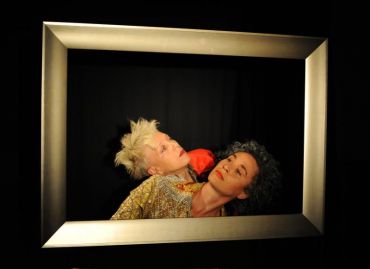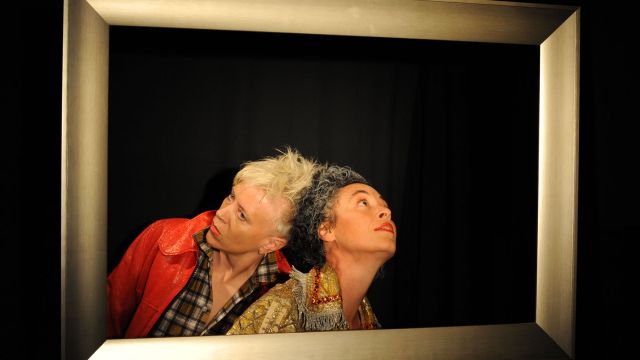Framed
The theatre is dark. An echoing beat breaks the stillness, resonates in the dark, then repeats and repeats. Soft light begins to focus on a frame encased above the covered stage front, where, gradually, two faces emerge. For the next fifty minutes, almost frustratingly controlled, and with almost imperceptible movement, they slowly take the audience through a series of emotions and minute connections – until the light, and the music, fade again to dark and silence. So concentrated is the atmosphere in the audience that a breathless quiet and stillness lingers for some time before applause begins.
This performance, by Tess De Quincey and Victoria Hunt, is a bringing together of butoh, BodyWeather and the ancient teachings of the Natyasastra, an ancient Indian treatise, written over 2000 years ago, covering all aspects of artistic practice, from dance and music to stage design and make up. De Quincey has concentrated this piece of theatre on the eight internal emotional states defined by the Natyasastra – love, pity, anger, disgust, heroism, awe, terror, comedy – and the fact that it teaches that these emotions, conveyed by minute body movements of the head and face, can impact on the emotions of the audience.
 To substantiate this, and because the intensity of each performance is affected by the atmosphere and feeling of the audience, De Quincey and Hunt converse with the audience after the performance to share impressions and perceptions and give a little more information about the form and the Natyasastra.
To substantiate this, and because the intensity of each performance is affected by the atmosphere and feeling of the audience, De Quincey and Hunt converse with the audience after the performance to share impressions and perceptions and give a little more information about the form and the Natyasastra.
The performance itself requires an enormous amount of focus and control. Each emotion slowly emerges through the tiniest of movements and glimpses of expression. The two heads very, very slowly weave around each other and sometimes, agonisingly it seems, almost connect. Across the faces, through the eyes and faint movements of the lips, the connection is lost and a new emotion begins, imperceptibly, to emerge.
For the audience the journey is just as concentrated and intense. With Michael Toisuta’s score, inspired by Ligeti’s Poeme Symphoniquefor 100 Metronomes, providing an echoing, sensory background, and all focus pinpointed on the micro movements in the frame, no one moves or reacts. De Quincey admits that the use of the frame suggests that it should be able to be viewed as in a gallery, from different angles. Comparisons with Munch’s “The Scream” come to mind.
Where butoh and BodyWeather the body reacts more to external sources, this performance concentrates on interpretation of internal emotions. It is unusual and intense and very demanding of both the performers – and the audience.
Carol Wimmer
Photographer: Heidrun Löhr
Subscribe to our E-Newsletter, buy our latest print edition or find a Performing Arts book at Book Nook.

